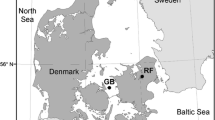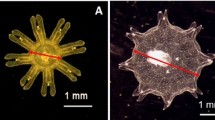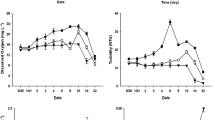Abstract
A series of incubation experiments were made to measure the rate of release of dissolved organic carbon (DOC) by the jellyfish Aurelia aurita (L.) (collected in 1991–1992 in Gullmarsfjorden, Sweden). Release of DOC by medusae (9.5 to 18 cm in diameter) from the Skagerrak ranged from 0.70 to 1.6 mg C ind-1 d-1 with a mean of 1.2 mg C ind-1 d-1 (SD=0.29 mg C ind-1 d-1, n=10). Based on data from the literature for two medusa populations, this can be equivalent to 2.5 and 7.1% of the carbon assimilated in one season (June to September). This was similar to the amount of carbon allocated to reproduction. Bacterial abundance was monitored to evaluate the possible stimulating effect of the DOC released. Bacterial growth was stimulated by the presence of A. aurita. The importance of A. aurita as a source of DOC on a large scale is small compared to exudate from primary producers. The volume surrounding each medusa, wherein the DOC released may be enough to sustain a bacterial production such as the one reported from the Swedish west coast, is equivalent to a sphere with a diameter of 0.5 m. Thus, considering the patchy distribution of medusae, the local influence of their DOC release could be important.
Similar content being viewed by others
References
Alldredge AL (1976) Discarded appendicularian houses as sources of food, surface habitats, and particulate organic matter in planktonic environments. Limnol Oceanogr 21:14–23
Arai MN (1992) Active and passive factors affecting aggregations of hydromedusae: a review. Scientia mar 56:99–108
Arai MN, Jacobs JR (1980) Interspecific predation of Common Strait of Georgia planktonic coelenterates: laboratory evidence. Can J Fish aquat Sciences 37:120–123
Azam F, Fenchel T, Field JG, Gray JS, Meyer-Reil LA, Thingstad F (1983) The ecological role of water-column microbes in the sea. Mar Ecol Prog Ser 10:257–263
Bailey KM, Batty RS (1984) Laboratory study of predation by Aurelia aurita on larvae of cod, flounder, plaice and herring: development and vulnerability to capture. Mar Biol 83:287–291
Bergström BI, Gustavsson A, Strömberg J-O (1992) Determination of abundance of gelatinous plankton with a Remotely Operated Vehicle (ROV) Arch Hydrobiol Beih Ergebn Limnol 36:59–65
Båmstedt U (1990) Trophodynamics of the scyphomedusae Aurelia aurita. Predation rate in relation to abundance size and type of prey organism. J Plankton Res 12:215–229
Caron DA, Goldman JC, Andersen KO, Dennett MR (1985) Nutrient cycling in a microflagellate food chain. II. Population dynamics and carbon cycling. Mar Ecol Prog Ser 24:243–254
Fenchel T (1982) Suspended marine bacteria as a food source. In: Fasham MJR (ed) Flows of energy and materials in marine ecosystems. Plenum Press, New York, pp 301–316
Gröndahl F (1988) A comparative ecological study on the scyphozoans Aurelia aurita, Cyanea capillata and C. lamarkii in the Gullmar Fjord. Mar Biol 97:541–550
Hamner WM, Madin LP, Alldredge AL, Gilmer RW, Hamner PP (1975) Underwater observations of gelatinous zooplankton: sampling problems, feeding biology, and behaviour. Limnol Oceanogr 20:907–917
Hamnen WM, Schneider D (1986) Regularly speced rows of medusae in the Bering Sea: role of Langmuir circulation. Limnol Oceanogr 31:171–177
Heeger T, Möller H (1987) Ultrastructural observations on prey capture and digestion in the scyphomedusa Aurelia aurita. Mar Biol 96:391–400
Hobbie JE, Daley RJ, Jasper S (1977) Use of Nucleopore filters for counting bacteria by fluorescence microscopy. Appl envirl Microbiol 33:1225–1228
Koroleff F (1970) Direct determination of ammonia in natural waters as indophenol blue. Conseil international pour l'éxploration de la mer. Service hydrographique. Information on techniques and methods for sea water analysis. Int counc Explor Sea (1970):19–22
Larsson U, Hagström Å (1982) Fractionated phytoplankton primary production exudate release and bacterial production in a Baltic eutrophication gradient. Mar Biol 67:57–70
Lee S, Fuhrman J (1987) Relationships between biovolume and biomass of naturally derived marine bacterioplankton. Appl envirl Microbiol 53:1298–1303
Lindahl O, Hernroth L (1983) Phyto-zooplankton community in coastal waters of western sweden — an ecosystem off balance? Mar Ecol Prog Ser 10:119–126
Metz P (1967) On the relations between Hyperia galba Montagu (Amphipoda, Hyperiidae) and its host Aurelia aurita in the Isefjord area (Sjaelland, Denmark). Vidensk Meddr dansk naturh Foren 103:85–108
Möller H (1980) A summer survey of large zooplankton, particularly scyphomedusae, in North Sea and Baltic Meeresforschung Rep mar Res 28:61–68
Möller H (1984) Reduction of a larval herring population by jellyfish predator. Science, NY 224:621–622
Norrman B (1993) Filtration of water samples for DOC studies. Mar Chem 41:239–242
Olesen NJ, Frandsen K, Riisgård HU (1994) Population dynamics, growth and energetics of jellyfish Aurelia aurita in a shallow fjord. Mar Ecol Prog Ser 105:9–18
Pomeroy LR, Deibel D (1980) Aggregation of organic matter by pelagic tunicates. Limnol Oceanogr 25:643–652
Rosenberg R, Dahl E, Edler L, Fyrberg L, Graneli E, Graneli W, Hagström Å, Lindahl O, Matos MO, Pettersson K, Sahlsten E, Tiselius P, Turk V, Wikner J (1990) Pelagic nutrient and energy transfer during spring in the open and coastal Skagerrak. Mar Ecol Prog Ser 61:215–231
Scavia D, Laird GA (1987) Bacterioplankton in Lake Michigan: dynamics, controls and significance to carbon flux. Limnol Oceanogr 32:1017–1033
Schneider G (1988) Chemische Zusammensetzung und Biomasseparameter der Ohrenqualle Aurelia aurita. Helgoländer Meeresunters 42:319–327
Schneider G (1989a) The common jellyfish Aurelia aurita: standing stock excretion and nutrient regeneration in the Kiel Bight, Western Baltic. Mar Biol 100:507–514
Schneider G (1989b) Estimation of food demands of Aurelia aurita medusae populations in the Kiel Bight/western Baltic. Ophelia 31:17–27
Southward AJ (1955) Observations on the ciliary currents of the jelly-fish Aurelia aurita L. J mar biol Ass UK 34:201–216
Stoecker DK, Michaels AE, Davis LH (1987) Grazing by the jelly-fish, Aurelia aurita, on microzooplankton. J Plankton Res 9:901–915
Strand SW, Hamner WM (1988) Predatory behavior of Phacellophora camtschatica and size-selective predation upon Aurelia aurita (Scyphozoa:Cnidaria) in Saanich Inlet, British Columbia. Mar Biol 99:409–414
Sugimura V, Suzuki Y (1988) A high-temperature catalytic oxidation method for determination of non-volatile dissolved organic carbon in seawater by direct injection of liquid sample. Mar Chem 24:105–131
van der Veer HW (1985) Impact of coelenterate predation on larval plaice Pleuronectes platessa and flounder Platichthys flesus stock in the western Wadden Sea. Mar Ecol Prog Ser 25:229–238
Wikner J, Hall SE, Olofsson S, Hagström Å (1986) In: Rosenberg R (ed) Swedish Environmental Protection Agency, Report 3272. Swedish Environmental Protection Agency. Stockholm, pp 83–95 (in Swedish)
Zweifel UL, Norrman B, Hagström Å (1993) Consumption of dissolved organic carbon by marine bacteria and demand for inorganic nutrients. Mar Ecol Prog Ser 101:23–32
Zweifel UL, Wikner J, Hagström Å, Lundberg E, Norrman B (1994) Dynamics of allochtonous dissolved organic carbon in a coastal ecosystem. Limnol Oceanogr (in press)
Author information
Authors and Affiliations
Additional information
Communicated by T. M. Fenchel, Helsingør
Rights and permissions
About this article
Cite this article
Hansson, L.J., Norrman, B. Release of dissolved organic carbon (DOC) by the scyphozoan jellyfish Aurelia aurita and its potential influence on the production of planktic bacteria. Marine Biology 121, 527–532 (1995). https://doi.org/10.1007/BF00349462
Received:
Accepted:
Issue Date:
DOI: https://doi.org/10.1007/BF00349462




